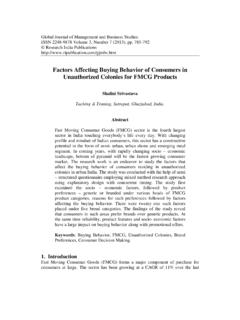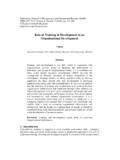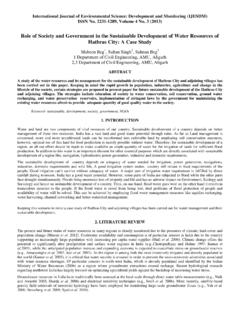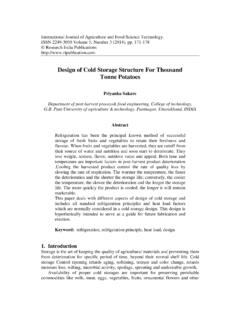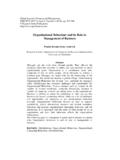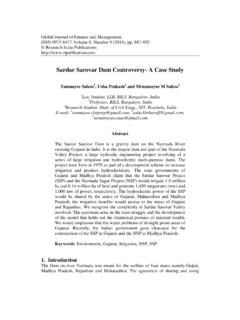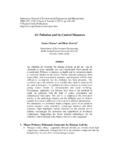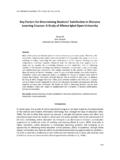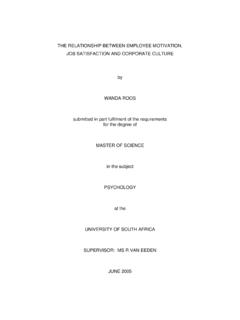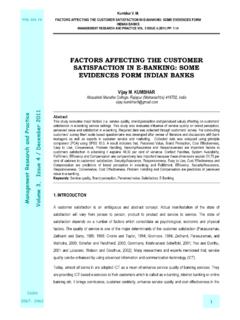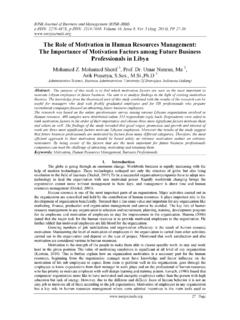Transcription of Study of Achievement Motivation in Relation to …
1 International Journal of Educational Planning & Administration. ISSN 2249-3093 Volume 1, Number 2 (2011), pp. 161-171 Research India Publications Study of Achievement Motivation in Relation to Academic Achievement of Students Kulwinder Singh Research Scholar, Singhania University, Rajasthan, India One of the most important factors that lead one to their goals is the drive. This drive is known as Motivation . It is a zest and determination with a kind of excitement that leads one to persevere to reach greater heights, in no matter what avenue of their life; be it personal or professional. The drive may come from an internal or external source. The individual determines this. The factors that motivate an individual keep changing as one climbs the ladder of age and maturity. And also, Achievement of one goal sets the ball rolling for another one to be achieved.
2 Thus, to be motivated is a constant need. There are times when one faces a period of de- Motivation and everything seems bleak. It is then that they need to find what would motivate them back into action. For every individual there is a variable driving force. In fact, it is not just a single factor, but a combination of factors that lead people to achieve their goals. The fact is that with routine monotony steps in and then everything seems like stagnant waters. It feels like there is nothing new. Breaking this cycle of monotony has helped many bounce back with enthusiasm. This is why human resource managers create a training calendar, which will take away employees from the routine they are stuck to, as well as enhance their skills in various areas. Others pursue hobbies during the weekend, thus giving them something to look forward to, as each week comes to a close.
3 There are people who redefine their goals and ambitions from time to time in order to fill them with newer levels of enthusiasm to achieve greater feats. One needs to take stalk every now and then and find the motivator required to carry them through. The word Motivation is coined from the Latin word "movere", which means to move. Motivation is defined as an internal drive that activates behavior and gives it direction. The term Motivation theory is concerned with the processes that describe why and how human behavior is activated and directed. It is regarded as one of the most important areas of Study in the field of organizational behavior. There are two different categories of Motivation theories such as content theories, and process theories. Even though there are different Motivation theories, none of them are universally accepted.
4 Also known as need theory, the content theory of Motivation mainly focuses on the internal factors that energize and direct human behavior. Maslow's hierarchy of 162 Kulwinder Singh needs, Alderfer's ERG theory, Herzeberg's motivator-hygiene theory (Herzeberg's dual factors theory), and McClelland's learned needs or three-needs theory are some of the major content theories. Motivation is the activation of goal-oriented is said to be intrinsic or extrinsic. The term is generally used for humans but, theoretically, it can also be used to describe the causes for animal behavior as well. This article refers to human Motivation . According to various theories, Motivation may be rooted in the basic need to minimize physical pain and maximize pleasure, or it may include specific needs such as eating and resting, or a desired object, hobby, goal, state of being, ideal, or it may be attributed to less-apparent reasons such as altruism, selfishness, morality, or avoiding mortality.
5 Conceptually, Motivation should not be confused with either volition or optimism.[1] Motivation is related to, but distinct from, emotion. Intrinsic and Extrinsic Motivation Intrinsic Motivation refers to Motivation that is driven by an interest or enjoyment in the task itself, and exists within the individual rather than relying on any external pressure.[2] Intrinsic Motivation has been studied by social and educational psychologists since the early 1970s. Research has found that it is usually associated with high educational Achievement and enjoyment by students. Explanations of intrinsic Motivation have been given in the context of Fritz Heider's attribution theory, Bandura's work on self-efficacy,[3] and Deci and Ryan's cognitive evaluation theory. Students are likely to be intrinsically motivated if they: Extrinsic Motivation comes from outside of the individual.
6 Common extrinsic motivations are rewards like money and grades, coercion and threat of punishment. Competition is in general extrinsic because it encourages the performer to win and beat others, not to enjoy the intrinsic rewards of the activity. A crowd cheering on the individual and trophies are also extrinsic incentives. Social psychological research has indicated that extrinsic rewards can lead to over justification and a subsequent reduction in intrinsic Motivation . In one Study demonstrating this effect, children who expected to be (and were) rewarded with a ribbon and a gold star for drawing pictures spent less time playing with the drawing materials in subsequent observations than children who were assigned to an unexpected reward condition and to children who received no extrinsic reward.
7 Achievement Motivation Motivation is generally regarded as the drive to achieve targets and the process to maintain the drive. Motivation provides an important foundation to complete cognitive behavior, such as planning, organization, decision-making, learning, and assessments (Pintrich & Schunk, 1996). Spence and Helmreich (1983) defined achievements as task-oriented behavior. Performances of individuals are often compared against standards or with others for assessments. The differing perspectives Study of Achievement Motivation in Relation 163 of scholars result in various definitions of Achievement Motivation . The original definition of Achievement Motivation was from Atkinson (1964), who defined it as the comparison of performances with others and against certain standard activities.
8 Atkinson and Feather (1966) suggested that Achievement Motivation is a combination of two personality variables: tendency to approach success and tendency to avoid failure. Bigge and Hunt (1980) defined Achievement Motivation as the drive to work with diligence and vitality, to constantly steer toward targets, to obtain dominance in challenging and difficult tasks and create sense of Achievement as a result. This definition consists of three elements: the stimulation of personal capabilities, constant efforts with drive and obtaining of sense of satisfaction. Helmreich & Spence (1978) consolidated the theories concerning Achievement Motivation and compiled the Work and Family Orientation Questionnaire (WOFO). Meanwhile, they conducted a factor analysis and argued that Achievement Motivation consists of four elements, mastery of needs, work orientation, competition, and personal unconcern.
9 After further studies, they found that the interaction of the first three elements is the key reason that contributes to excellent performance of individuals. It is highly related to personal achievements (Spence & Helmreich, 1983). 1. Mastery of needs: An individual prefers jobs that are challenging, intellectually demanding, and thought-oriented. He or she enjoys playing a leadership role in groups and is able to complete tasks already started. 2. Work orientation: An individual takes a proactive attitude toward work and loves what he or she does. He or she obtains sense of satisfaction from work and pursues self-realization and growth. 3. Competition: An individual hopes for victory and has the desire to win over others. 4.
10 Personal unconcern: An individual does not consider success or stellar performance to be the cause of being rejected by others. In other words, there is no fear of success. According to the above literature, Achievement Motivation is a subjective and internal psychological drive, enabling individuals to pursue work they perceive to be valuable and prompting them to reach their goals. Meanwhile, Achievement Motivation is also a mentality to compete and compare with others. According to definitions, as proposed by the previously mentioned scholars, Achievement Motivation is a subjective, internal, and psychological drive, enabling individuals to pursue work they perceive to be valuable and eventually achieve their goals. Sparrow (1998) found that motivations have influence on the formation of psychological contracts.

